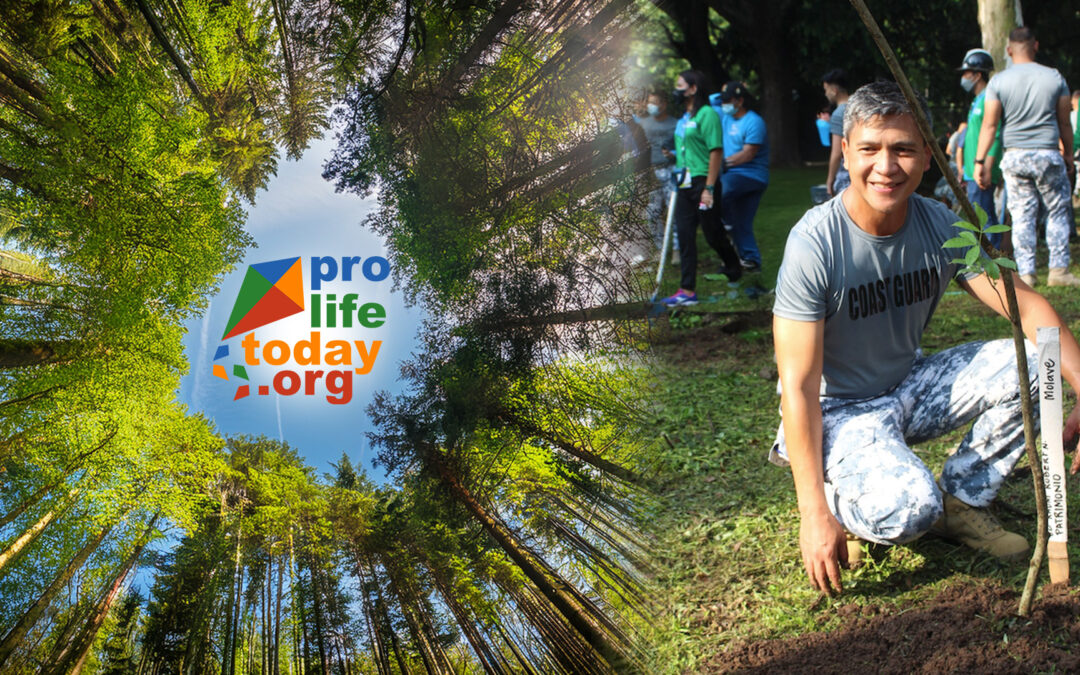NATIONAL ADVOCACY FOR CLIMATE RESILIENCE AND COASTAL PROTECTION
During his tenure as Commander of the Marine Environment Protection Command of the Philippine Coast Guard, Vice Admiral Robert N. Patrimonio, PCG (Ret.), was a tireless advocate for habitat restoration—especially in promoting the role of natural buffers like forests and mangroves in strengthening resilience to flash floods, storm surges, and coastal erosion. His push for nature-based solutions aligned closely with reforestation efforts in upland and coastal zones.
Now, as President of PROLIFETODAY, with the motto “Human Nature Harmony” and the theme “Protecting Life, Preserving Nature,” he continues to amplify advocacy for:
-
Upland mountain reforestation to reduce flash flooding and landslides
-
Coastal mangrove and native forest vegetation restoration to guard against storm surges and erosion
Why Planting Trees Matters—In the Mountains and By the Shore
Mountains and Watersheds: Stopping Flash Floods and Landslides
Trees in upland and watershed areas hold soil in place with deep roots, reduce erosion, promote infiltration of heavy rain, and slow runoff—helping to prevent destructive flash floods downstream. Mature trees can hold 1,500–2,000 liters of water each, buffering floods and stabilizing soils.
Deforestation has shrunk Philippine forest cover from about 70 % to just 23 %, worsening flood risks and landslides across Luzon, Visayas, and Mindanao.
Coastal Zones: Natural Bulwarks Against Storms and Surges
Restoring mangrove belts and other coastal forest vegetation can reduce wave energy by up to 66 percent, serving as living seawalls that protect shorelines and communities.
In recent years, provinces like Negros Occidental have launched coastal restoration initiatives that have successfully rehabilitated over 1,000 hectares of mangrove and coastal forests—becoming models for climate resilience and disaster risk reduction.
Climate Change: Intensifying the Stakes
The Philippines is among the world’s most climate-vulnerable nations—facing faster sea level rise, more powerful typhoons, heavier rainfall, flooding, and landslides.
Rising sea levels, ocean acidification, and warming seas threaten mangroves, coral reefs, fisheries, and low-lying communities. More than 60 percent of Filipinos live in coastal areas that are increasingly at risk.
Trees and mangroves also act as major carbon sinks. Forests globally sequester billions of tons of carbon annually, helping mitigate global warming and supporting the goals of the Paris Agreement.
Legal Backbone: Key Philippine Environmental Laws Supporting Reforestation
-
Republic Act 115 (1947) created a Reforestation Fund, financing tree planting in denuded lands, watersheds, and eroded areas to prevent floods and erosion.
-
Republic Act 10452 (2013) mandates reforesting 3,000 hectares in Cagayan de Oro City specifically to protect people from flash floods.
-
Executive Order 533 (2006) institutionalized Integrated Coastal Management (ICM) as a national strategy, promoting holistic planning to protect coastal and marine ecosystems.
-
Presidential Decree 1152 (1977) emphasizes soil, watershed, floodplain, shore, and riverbank conservation—including erosion control and flood mitigation through vegetation restoration.
-
The Climate Change Act (RA 9729, amended 2012) created the Climate Change Commission and the People’s Survival Fund, financing adaptation projects such as reforestation and mangrove rehabilitation.
-
The Writ of Kalikasan (2010) protects the constitutional right to a balanced and healthful ecology—empowering citizens and institutions to take legal action when environmental damage endangers life and property.
PROLIFETODAY’s Mission: Scaling Up from Advocacy to Action
Under Vice Admiral Patrimonio’s leadership, PROLIFETODAY is advancing a comprehensive agenda:
-
Strengthening implementation of existing reforestation and coastal management laws
-
Advocating for a national Coastal Greenbelt Law, requiring a minimum buffer zone of mangroves and coastal forest vegetation in vulnerable areas
-
Restoring degraded watersheds, especially in critical zones like the Sierra Madre and Cordillera ranges
-
Partnering with local governments, civil society, and indigenous communities to expand grassroots reforestation and environmental stewardship
-
Promoting climate-resilient reforestation projects funded by the People’s Survival Fund and other adaptation mechanisms
-
Using legal tools like the Writ of Kalikasan to demand accountability and action in defense of ecological integrity
Reforestation as Protection, Restoration, and Renewal
With climate change accelerating extreme weather, flooding, and coastal degradation, nature-based solutions such as upland reforestation and coastal forest restoration are now essential.
Vice Admiral Robert N. Patrimonio has consistently championed these strategies—first through the Philippine Coast Guard and now through PROLIFETODAY. His leadership is grounded in science, policy, and community action. By promoting stronger enforcement of laws like RA 10452 and RA 9729, and supporting new legislation to protect natural buffers, he affirms his vision: Protecting Life, Preserving Nature.
In a nation where people are deeply connected to land and sea, tree planting is more than symbolic—it is a national imperative for safety, resilience, and harmony.

